Artists Who Make Art With Trash From the Ocean
Since 2010, Angela Pozzi'southward Washed Ashore projection has transformed an amazing twenty tons of marine trash into over 70 works of arresting larger-than-life public art works, drawing much-needed attention to the epidemic of plastic pollution and its negative impact on endangered species. What started every bit Pozzi's personal attempt to go along a beach beautiful has go a global phone call to activity with shocking visual and educational touch, as the lifelong sculpture creative person and her team of volunteers harness the power of collective piece of work to starting time a revolution in the way we approach our beaches. The medium is, truly, the message. Oceanic Global spent an hour in chat with Pozzi, learning nearly the surprising origins and exciting growth of Washed Ashore. The interview has been edited for clarity and length.
Tin can y'all tell u.s.a. about your background and the origins of Done Ashore?
Outset of all, I've always loved the ocean. It's where I spent all my summers equally a child; it was always the place where it felt like I connected to the world.
I was as well raised by 2 artists, and I grew up realizing that the arts are an of import linguistic communication, and that I was very privileged to be able to speak those fluently. As I grew upwards, I kept wondering why nobody else understood art like I did, and I decided to go an fine art instructor because I thought: information technology doesn't seem right that people don't empathise how important fine art – all the arts – are. I eventually became an art teacher for 30 years — art and creative dance — and I helped start two arts magnet schools, where you integrate all the arts into the field of study areas, in the Portland, Oregon surface area.
What were yous working on before Washed Ashore happened — and how did this projection really come alive?
In my ain artwork, I scrounged materials from austerity stores and found objects; I was an exhibiting artist starting in nearly 2000. I was married to an artist and teacher, Craig Pozzi, and we both were doing the same kind of matter. We were married 24 years before suddenly he had a massive collapse and was rushed off to emergency brain surgery with a brain tumor. Nosotros didn't know what was going on, but he came through that. Then a year afterward he had a massive stroke; he was disabled. And a year later, he died.
We were very close, and I was just a wreck. Nosotros were living in the Portland expanse, and the simply thing I could think of to attempt to observe a reason to live and a reason to practice art was to go to the ocean. So I said to myself, I'll get to the bounding main where I tin can try to heal and meet beauty and effort to discover my purpose in life.
So I moved to Curve in Oregon, where my family unit had a cabin on a little lake for 85 years. I took my dog to the beach every day and walked the beach. At first I kind of stepped over the garbage. In that location wasn't a lot of information technology; there was just a little bit here and at that place. I just didn't want to see information technology, because I needed beauty. Only it withal kept nagging at me – what is that stuff on the sand?
I walked onto this 1 beach and I was merely shocked. There was a rack line of plastics going away as far as the middle could see. I was absolutely horrified.
I saw people along the shoreline picking upwardly agates and shells with their petty buckets, and I idea, I accept to figure out how to get those people to pick upwardly this stuff. And I accept to get them to see.Because nosotros can't not come across information technology — this is bad.
So I decided to only use garbage from the embankment every bit my medium.
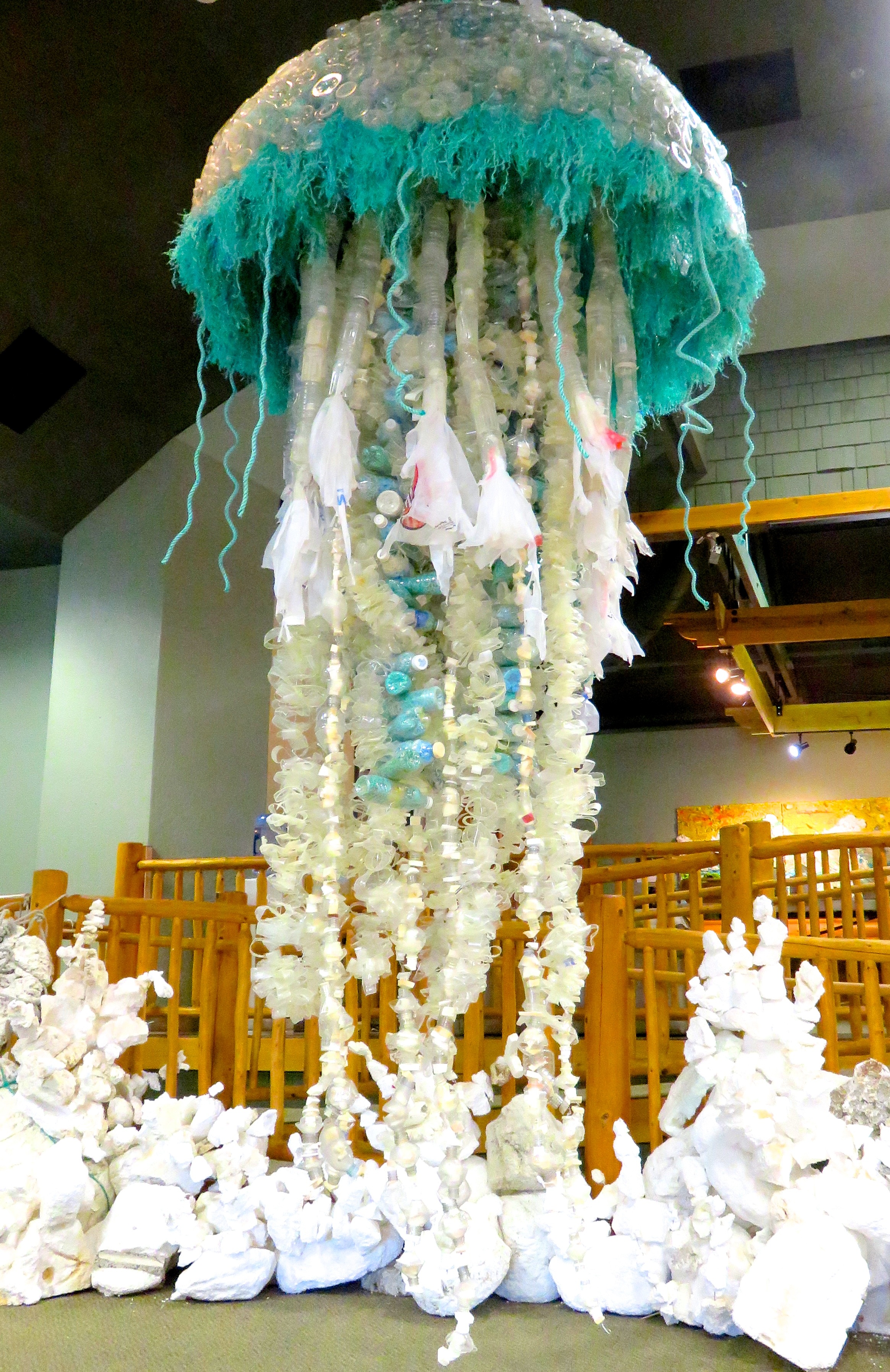
I knew from my male parent, who was director of the Washington State Arts Commission for 12 years and had done a lot of work with public fine art – I knew it had to exist public, and it had to be big. The biggest issue with public fine art is it's not big enough; people ignore it, people don't come across it.
So I thought, information technology has to be big, and it has to be something that anybody loves — so animals that were threatened by marine debris. So I thought: how about a large fish that everyone wants their picture taken adjacent to, and can go viral? And everything came together, and suddenly I found a purpose in life.
Ideally this will reach people globally, and we'll accept information technology be an epidemic art showroom, where anybody will see it – and nosotros'll start Done Ashore projects in other parts of the world, and they would brand sculptures from their beaches and they would tour them, and spark another person.
Now it'southward 6 years after. We started the whole non turn a profit in 2010. I accept 9 employees, and 10,000 volunteers.
Tin you talk a petty well-nigh the concrete process – how long does it accept to complete one of these massive works? Are there whatsoever detail challenges involved in collecting the debris and getting people together to do information technology?
That'southward the i thing that I really like to tell people: you don't have to organize a beach cleanup. Nosotros take constant influx of garbage.
People drib off the raw debris. Then nosotros sort through information technology, using pretty much everything, virtually 95% — which is a real challenge, creatively, because I don't desire to recycle any of information technology; I want people to see how much there is. If I recycled all the water bottles, then nobody would realize how many water bottles wash ashore. The only things nosotros don't utilize are toxic things or stuff that's as well photo-degraded for us to use.
Once we hose everything down, we start sorting it by type of things. And so nosotros vinegar wash, and use biodegradable soap. We scrub it, we scrape it; we put things in our aging yard that have too many barnacles attached, and allow the raccoons and the slugs do their job. We let the rain do its job. And and then nosotros sort it by color.
From there, it'south a constant design process. We never, always supplement with anything that'due south not from the beach.
So locals in your town are used to being a part of this?
Oh, yes. We as well live in a tourist town, and then we get people from all over the world. We've processed about 20 tons of garbage now into about lxx sculptures. And we're making new ones all the time.
What kind of team are you working with that'southward helping yous doing the structure for the pieces?
That'south the heady role: nosotros rely on volunteers for a massive amount of information technology. We bring in petty parts of things that people can wire-stitch together. We have stuff that kids can do that are 3 years onetime, and we have things for adults that are more circuitous. I have a workshop space at our gallery where people can come in: they can stay for 15 minutes, they can walk through, or they can sit down and brand a part of the sculpture.
All those parts are quality checked – everything has to exist 100-mile-an-hour windproof, because they might terminate upwards outside. And those parts of pieces come dorsum to the sculpture processing, and I have an apprentice and art assistant that work with me to adhere those pieces to the large steel frame – we accept a welded steel frame that we create. But it'due south a strange, strange world, to piece of work with marine debris. You lot can't plan as well far ahead unless y'all know something that'due south commonly washed up.
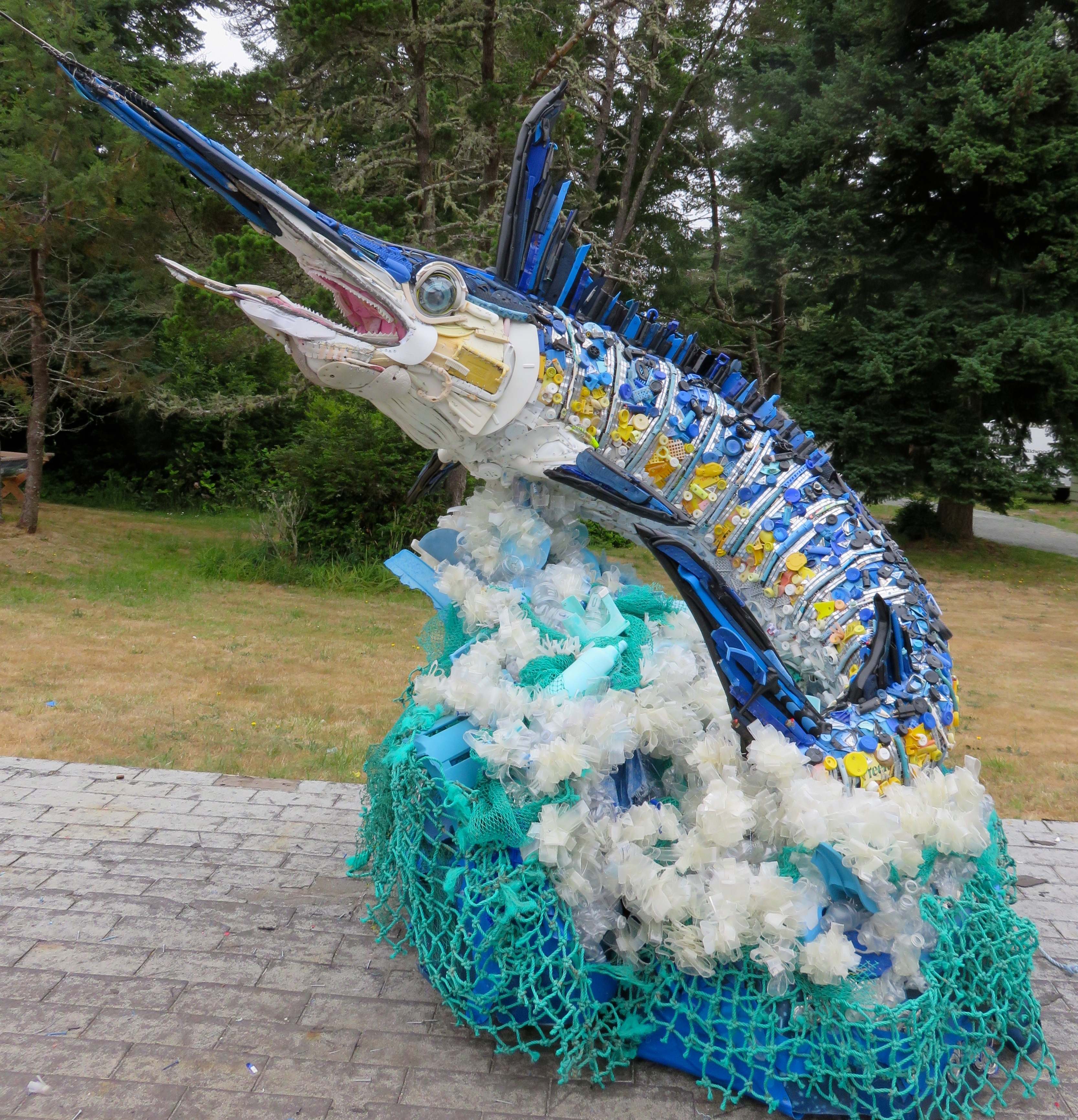
Then y'all said at that place are nearly 70 works you lot've created over the last 6 years or so – what happens to them? What's the time to come of these pieces?
Some of those pieces are on permanent sites, where they were deputed. Mostly we find that exhibiting at zoos, aquariums, and scientific discipline centers is actually a neat fashion of getting the message out, because nosotros connect with their didactics staff, and sometimes the animal is correct there, and so their education connects with what our message is.
Nosotros take three touring exhibits correct now, one at the Georgia Aquarium, one at the Smithsonian National Zoo, and then we have our exhibit hall here in Curve. Adjacent year we're already booked through the entire yr at botanical gardens also, a scientific discipline museum, and a zoo.
Do you have a specific memorable experience in your career as an artist and equally an ocean advocate that stands out to you as a big accomplishment, or something you're actually excited virtually?
There are two of them.
I remember this i woman who came into the exhibit, and she stood there and she just started crying. I went up to her, and I asked her, "Is at that place anything I tin can answer? Are you doing OK?"
And she said, "This has impacted me so powerfully. I will never look at the world the same. What can I do?"
I've seen it several times: our work just brings people to tears. The arts can attain the heart in a way that facts and figures and scientific discipline only can't do sometimes. Over and over, I hear: this has changed the manner I think about the world. And I go, Great! That's a good start. That fuels me to keep doing this piece of work.
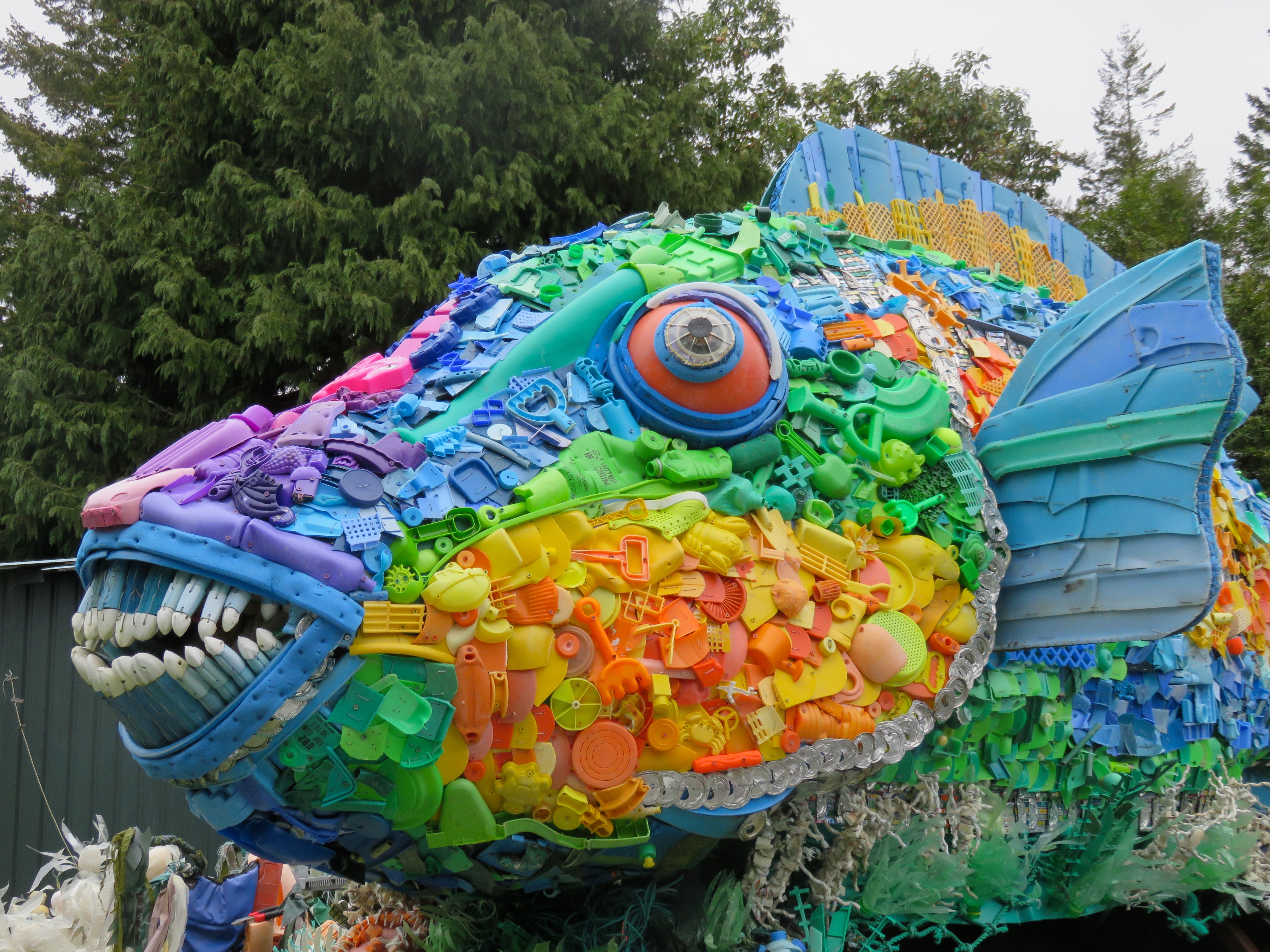
What kind of reaction would y'all similar people to have to these pieces – and what message exercise you want them to have abroad?
I desire people to finish and think near what they're doing. To brand meliorate choices. As consumers, if we can demand something dissimilar, we can make a difference.
We're non a political activist organization. I'm very conscientious about that; nosotros want the doors open to work with everybody.
The ane other thing that's personally the about pregnant thing that's e'er happened is that I was asked by the Smithsonian Museum of Natural History to do a display case for them. I've never felt so much pressure to do things correct, and exercise things scientifically. I just completed that and installed information technology in June of this year; it should be there for i to 3 years. I tried to make information technology rich with teachable moments. It'due south 12-foot long, a endangered Hawksbill turtle tangled in net, swimming over a reef that'southward bleaching out, surrounded by sea jellies and a plastic pocketbook.
It's a huge laurels.
What'due south next? What would yous like to piece of work on next?
We have had quite a chip of interest in the satellite projects. We've been growing and then fast that we're trying to brand sure that we're able to go overseas, which would be wonderful, just that'due south a huge jump for a small not-profit.
I call up having some permanent pieces in zoos and aquariums is a really smashing next stride for u.s. — to make sure that this messaging is constant, that it's ever at that place.
If in that location's one affair that y'all retrieve people should practise, or that you'd like them to walk away from seeing your art doing, what is that thing?
Stop using plastic h2o bottles. So simple! Information technology'due south so simple. Buy a reusable water bottle. And plastic numberless – eliminate a plastic pocketbook, and use a reusable bag.
What is the weirdest matter that's washed up and come up into your studio that you've incorporated into a piece?
Well, you know, I don't think in that location's anything weird at this signal because I've seen then much. The most profound, astonishing, and constantly shocking thing that I find are the bottles – usually lotion bottles and motor oil containers – with bite marks in them. Information technology's and then obvious that the fish are eating it; it simply can't exist denied. When you lot see these, it's like, oh my God, what'south that doing to the animal? Every time I see 1, information technology gets me.
It'south really funny because at the very beginning of this project I presented to a group of scientists almost what I was doing, and I showed this slice. And later a group of scientists came upward and gathered around me, and they said, you have to keep doing this piece of work. You tin can prove things and say things that we can't in science. And people volition see it, and you'll kickoff having touch on before the science comes out.
Now the science is coming out, 6 years later. But when you actually see this stuff – you can't deny information technology. It'southward correct there in front of y'all.
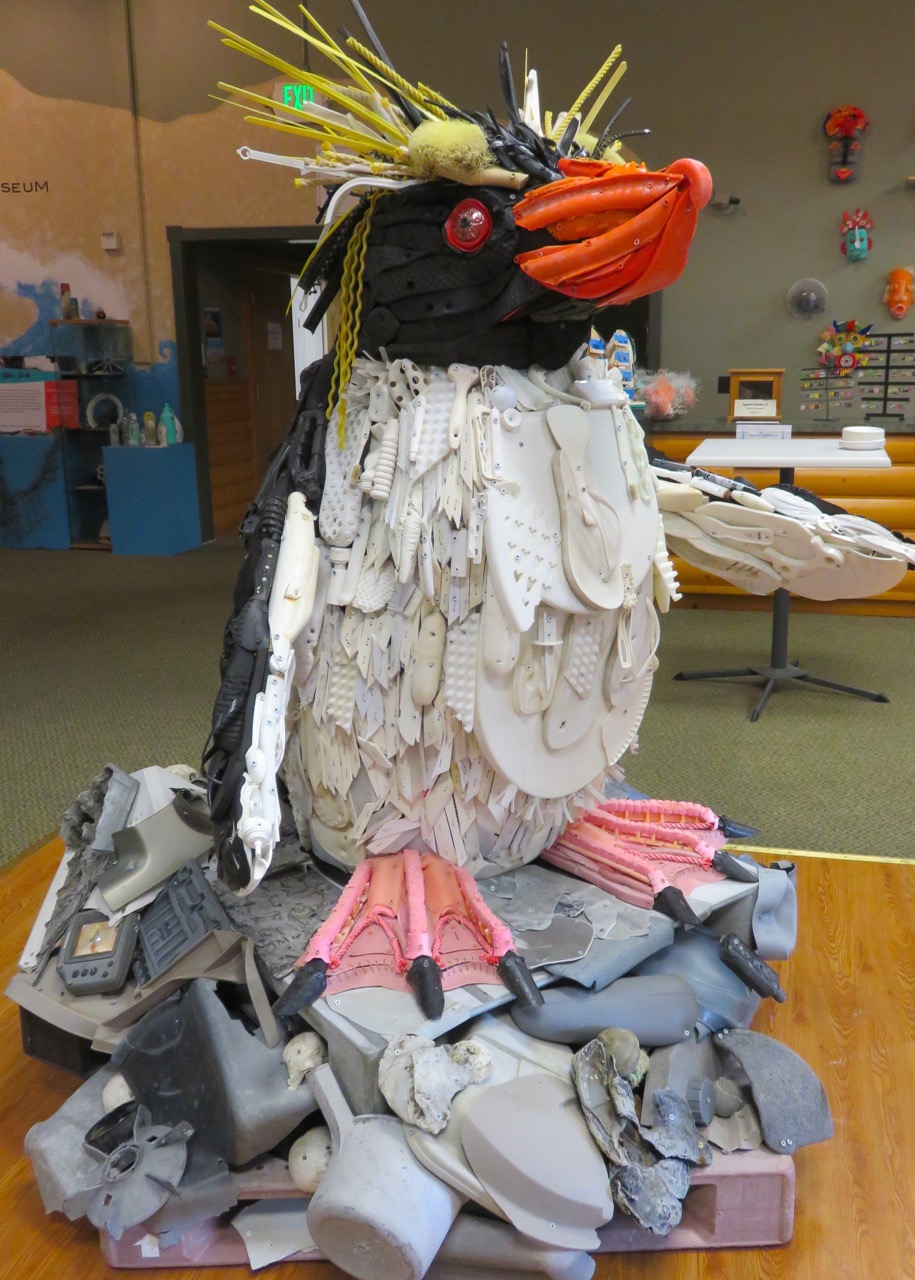
Is there annihilation else you'd like to add?
There'southward one thing I really value about Done Aground, and that is that we're a metaphor for how we can help solve environmental bug. We work with hundreds and thousands of people that just make 1 lilliputian contribution. They may not even see the terminal product, but they had faith that the small activity would help solve a trouble and aid educate.
All these sculptures were made because people believed that their action counted. We tin prove you a visual, tactile case that every action actually does brand a difference. We tin can show that in that location'due south hope; people tin can do amazing things when nosotros piece of work together. We can get ourselves out of this mess if we all piece of work together. I tend to be optimistic. You have to believe that practiced will conquer evil.
Discover more at WashedAshore.org.
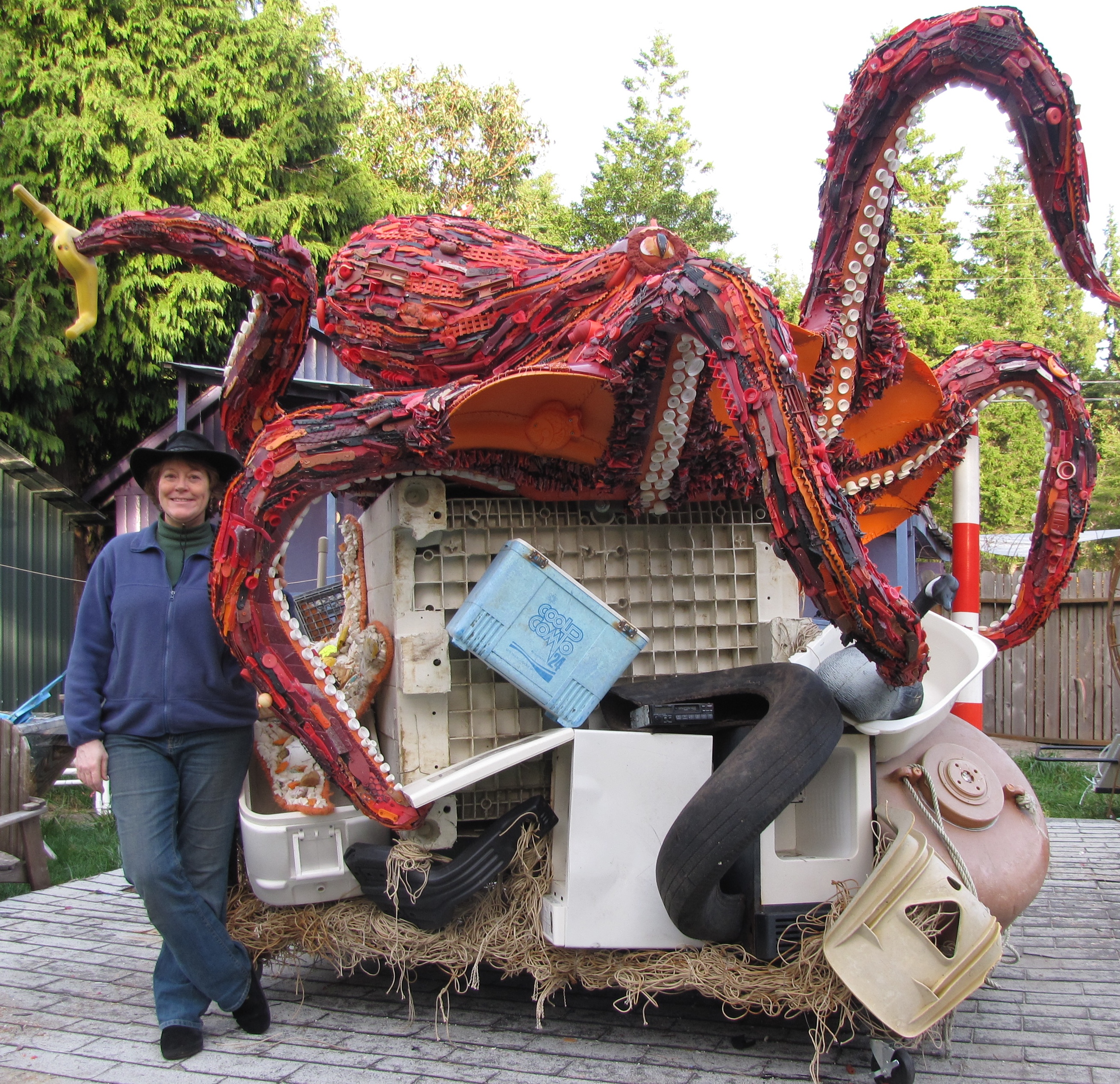
massy-greenememen1996.blogspot.com
Source: https://oceanic.global/angela-pozzi-of-washed-ashore/
0 Response to "Artists Who Make Art With Trash From the Ocean"
Post a Comment